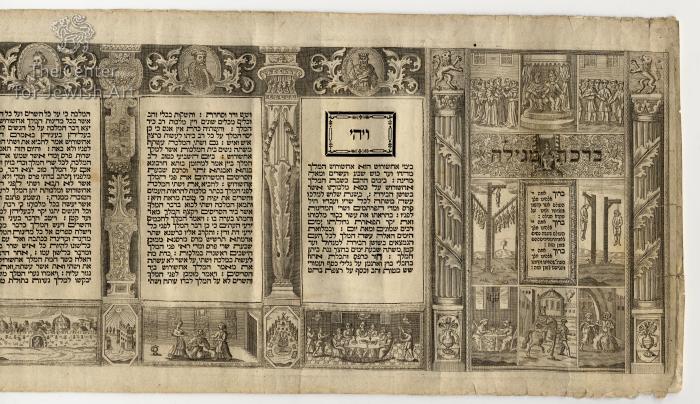Img. ID: 341352

Opening decoration (sheet no. 1): The scroll opens with a panel containing several narrative scenes from the Esther story. In the central part of the upper register, the royal couple seated on the throne with a canopy that is placed on a pedestal is represented. The king and the queen are accompanied by courtiers; on the right, the princes of Media and Persia are standing (Es. 1:14) and on the left, there are Esther's maidservants (Es. 2:9). In a rectangular panel, directly below, Esther is shown seated on a throne surrounded by elaborate tendrils, small lions, birds, heads of angels and the Hebrew printed words ברכת מגילה - "blessings for the Megillah". Below, there are three rectangular frames: the central panel contains the benedictions recited before the Megillah reading, the panel on the right shows the chamberlains, Bigthan and Teresh, hanging on two gallows (Es. 2:23), whereas the one on the left depicts Haman and his sons hanging on three gallows (Es. 7:10 and Es. 9:14 or Es. 9:25). The lowest register contains three episodes that are (from right to left): Mordecai receiving the clothes from Hatach (Es. 4:4), Haman leads Mordecai through the streets of Susa (Es. 6:11), Esther and Mordecai write letters instructing the Jews to observe Purim (Es. 9:29).
Text column no. 1 (sheet no. 1): The initial word of the Megillah (ויהי) is enlarged and framed. In the upper margin, above the column, a medallion with a bust of the king flanked by acanthus leaves is depicted. In the lower margin, the feast of the king is shown (Es. 1:3-8) - there are six men seated at a round laid table; additionally, on either side of the table, servants are visible.
Text column no. 2 (sheet no. 1): In the upper margin, a bust of a man with a mustache and a cap on his head (Haman?) is shown. In the lower margin, Queen Vashti is portrayed while she is strangled by two women standing on either side of her. During the execution, she keels with hands folded on the chest, and the crown lies on the floor, behind her. The Book of Esther does not mention the fate of Vashti after her refusal of the king's order and the source for this representation remains unknown.
In the octagons separating the frames are depicted (from right to left): 1) a vase with flowers, 2) a (palace?) garden with a fountain, 3) a cityscape with a sun shining over a city.
A | Acanthus Leaf
C | Columns
V | Vase
L | Landscape
O | Ornamentation: | Architectonic motif
L | Lion
O | Ornamentation: | Foliate and floral ornaments | Floral motif
H | Human Figure | Bust (Human figure)
E | Esther, Book of (following the order of the story) | Ahasuerus and the seven princes of Persia and Media (Es. 1:13-15) | Seven princes of Persia and Media (Es. 1:14)
E | Esther, Book of (following the order of the story) | Seven maidens given to Esther (Es. 2:9)
E | Esther, Book of (following the order of the story) | Bigthan and Teresh hanged (Es. 2:23)
E | Esther, Book of (following the order of the story) | Haman hanged (Es. 7:10)
E | Esther, Book of (following the order of the story) | Haman's sons hanged (Es. 9:14)
E | Esther, Book of (following the order of the story) | Haman and his ten sons hanged (Es. 9:25)
E | Esther, Book of (following the order of the story) | Mordecai receiving clothes from Hatach (Es. 4:4)
E | Esther, Book of (following the order of the story) | Mordecai's triumph (Es. 6:11)
E | Esther, Book of (following the order of the story) | Esther confirms the second letter of Purim (Es. 9:29)
E | Esther, Book of (following the order of the story) | Ahasuerus' banquet (Es. 1:3-8)
E | Esther, Book of (following the order of the story) | Execution of Vashti - strangulation
O | Ornamentation: | Initial word, framed
O | Ornamentation: | Foliate and floral ornaments | Foliate motif
|



